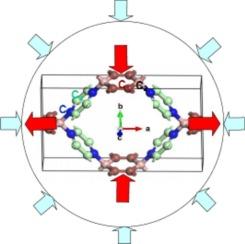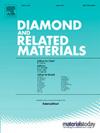First principles study of the electronic and mechanical properties of a porous carbon
IF 4.3
3区 材料科学
Q2 MATERIALS SCIENCE, COATINGS & FILMS
引用次数: 0
Abstract
Carbon is a versatile element in the periodic table, which can form many allotropes with various properties in nature. In this work, the electronic and mechanical properties of a low energy porous carbon, a topological nodal line material, are studied by first principles method. Elastic and dynamical stabilities under hydrostatic pressure are investigated, which reveal that the dynamical instability occurs first. It is a material with negative linear compressibility along the a axis. Tension and compression strains are applied in different crystal orientations to obtain the corresponding stresses. The results indicate that the c axis can endure the smallest strains, the a axis can withstand moderate ones while the b axis can bear the largest ones, however, the resulted stresses have very different behaviors. Shear strains are exerted on different crystal planes to see the corresponding mechanical responses, which uncover that the (100)[010] shear pattern has the lowest critical stress than other shear patterns. The crystal structure, dynamical stability, and electron density difference under the critical strains are checked. The reasons for the different mechanical behaviors under pressure and strain are proposed. The effects of pressure and strain on its topological property are also studied.

多孔碳电子和机械特性的第一原理研究
碳是元素周期表中的一种多功能元素,在自然界中可以形成许多具有不同性质的同素异形体。本研究采用第一性原理方法研究了拓扑节点线材料--低能多孔碳的电子和机械特性。研究发现,静水压力下的弹性稳定性和动力学稳定性首先出现动力学不稳定性。这是一种沿 a 轴具有负线性可压缩性的材料。在不同的晶体取向上施加拉伸和压缩应变,以获得相应的应力。结果表明,c 轴可以承受最小的应变,a 轴可以承受中等的应变,而 b 轴可以承受最大的应变。对不同的晶面施加剪切应变,观察其相应的力学响应,结果发现 (100)[010] 剪切模式的临界应力比其他剪切模式最低。研究还检测了临界应变下的晶体结构、动态稳定性和电子密度差。提出了在压力和应变下产生不同力学行为的原因。此外,还研究了压力和应变对其拓扑特性的影响。
本文章由计算机程序翻译,如有差异,请以英文原文为准。
求助全文
约1分钟内获得全文
求助全文
来源期刊

Diamond and Related Materials
工程技术-材料科学:综合
CiteScore
6.00
自引率
14.60%
发文量
702
审稿时长
2.1 months
期刊介绍:
DRM is a leading international journal that publishes new fundamental and applied research on all forms of diamond, the integration of diamond with other advanced materials and development of technologies exploiting diamond. The synthesis, characterization and processing of single crystal diamond, polycrystalline films, nanodiamond powders and heterostructures with other advanced materials are encouraged topics for technical and review articles. In addition to diamond, the journal publishes manuscripts on the synthesis, characterization and application of other related materials including diamond-like carbons, carbon nanotubes, graphene, and boron and carbon nitrides. Articles are sought on the chemical functionalization of diamond and related materials as well as their use in electrochemistry, energy storage and conversion, chemical and biological sensing, imaging, thermal management, photonic and quantum applications, electron emission and electronic devices.
The International Conference on Diamond and Carbon Materials has evolved into the largest and most well attended forum in the field of diamond, providing a forum to showcase the latest results in the science and technology of diamond and other carbon materials such as carbon nanotubes, graphene, and diamond-like carbon. Run annually in association with Diamond and Related Materials the conference provides junior and established researchers the opportunity to exchange the latest results ranging from fundamental physical and chemical concepts to applied research focusing on the next generation carbon-based devices.
 求助内容:
求助内容: 应助结果提醒方式:
应助结果提醒方式:


